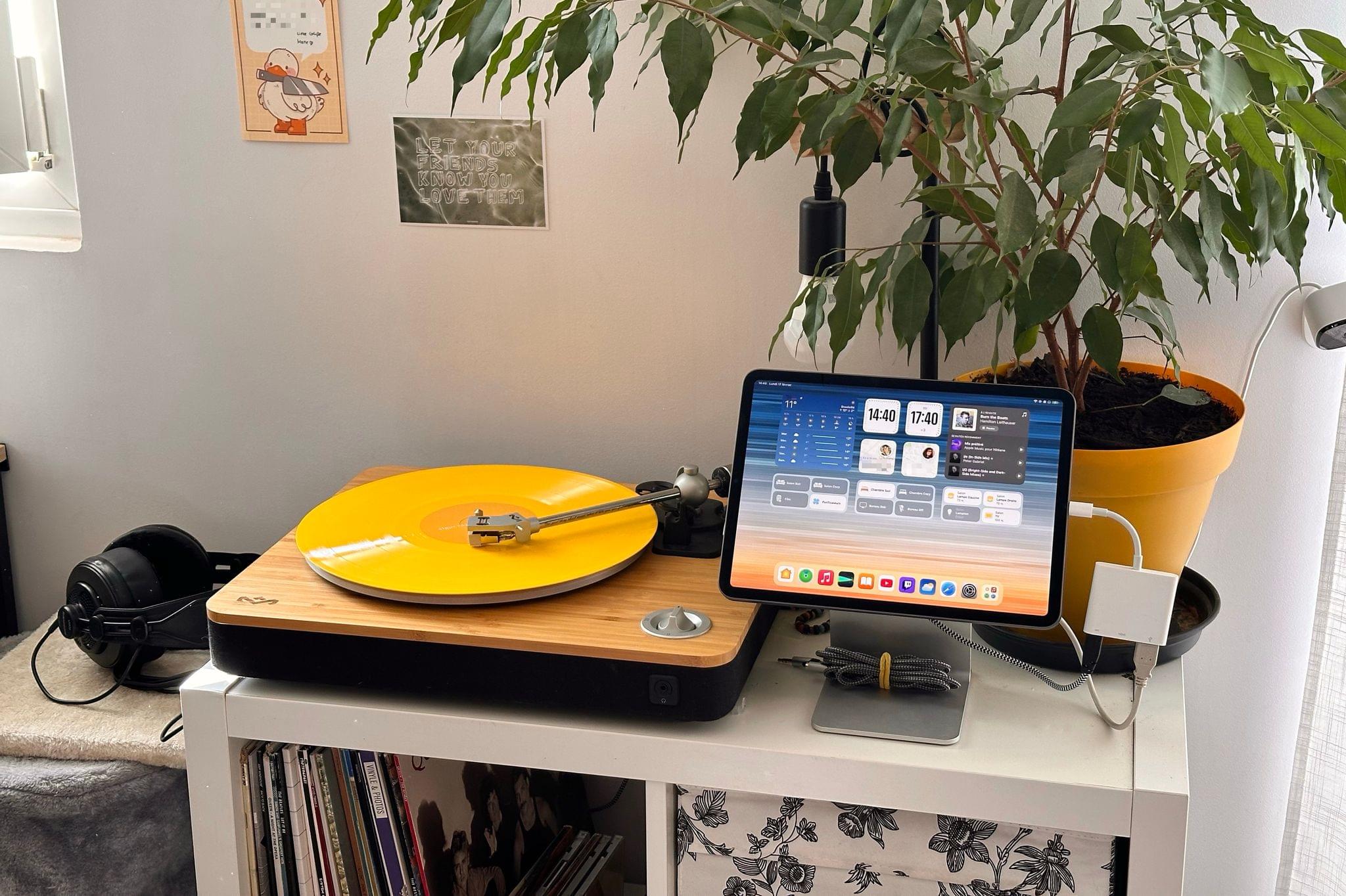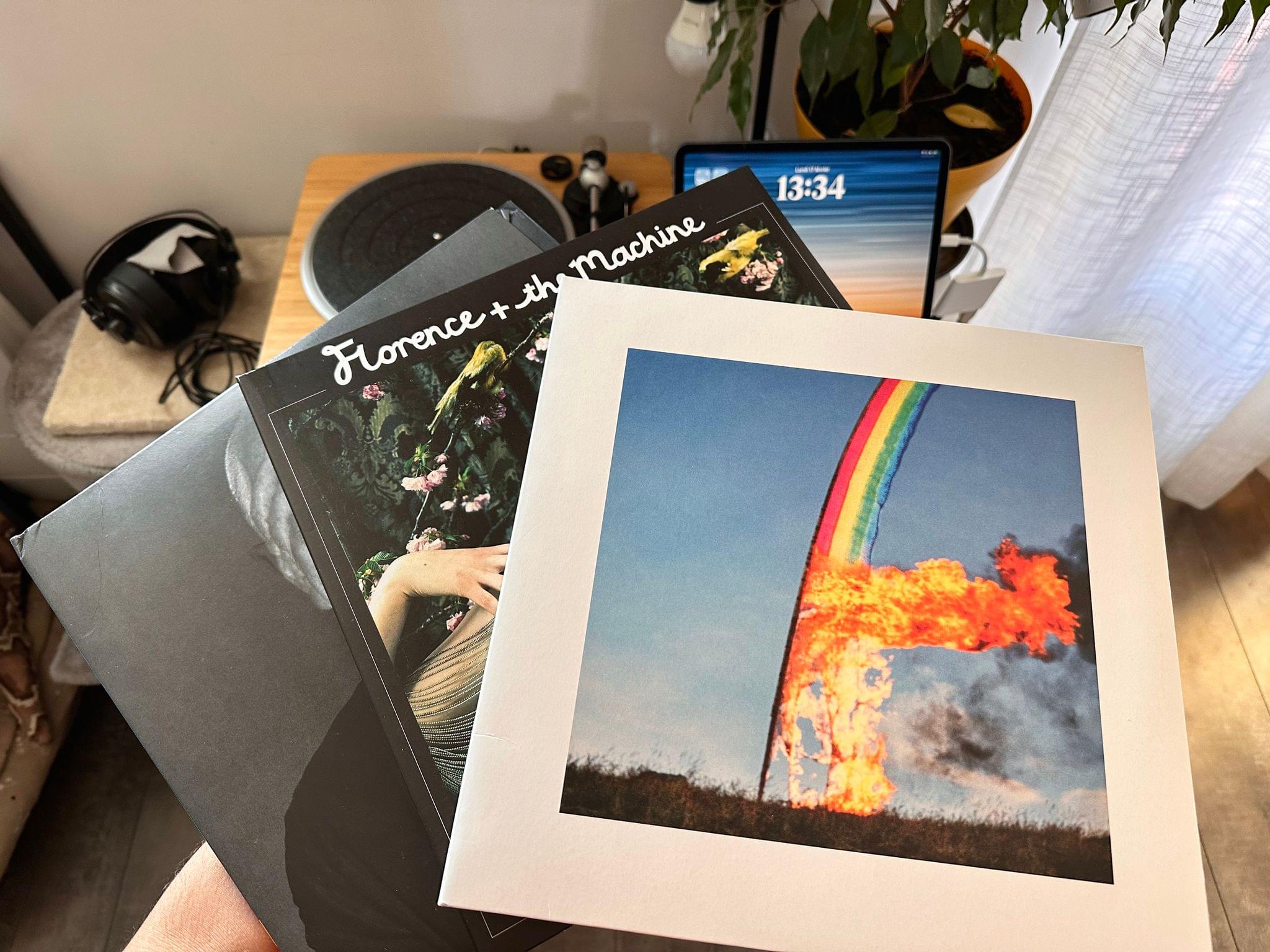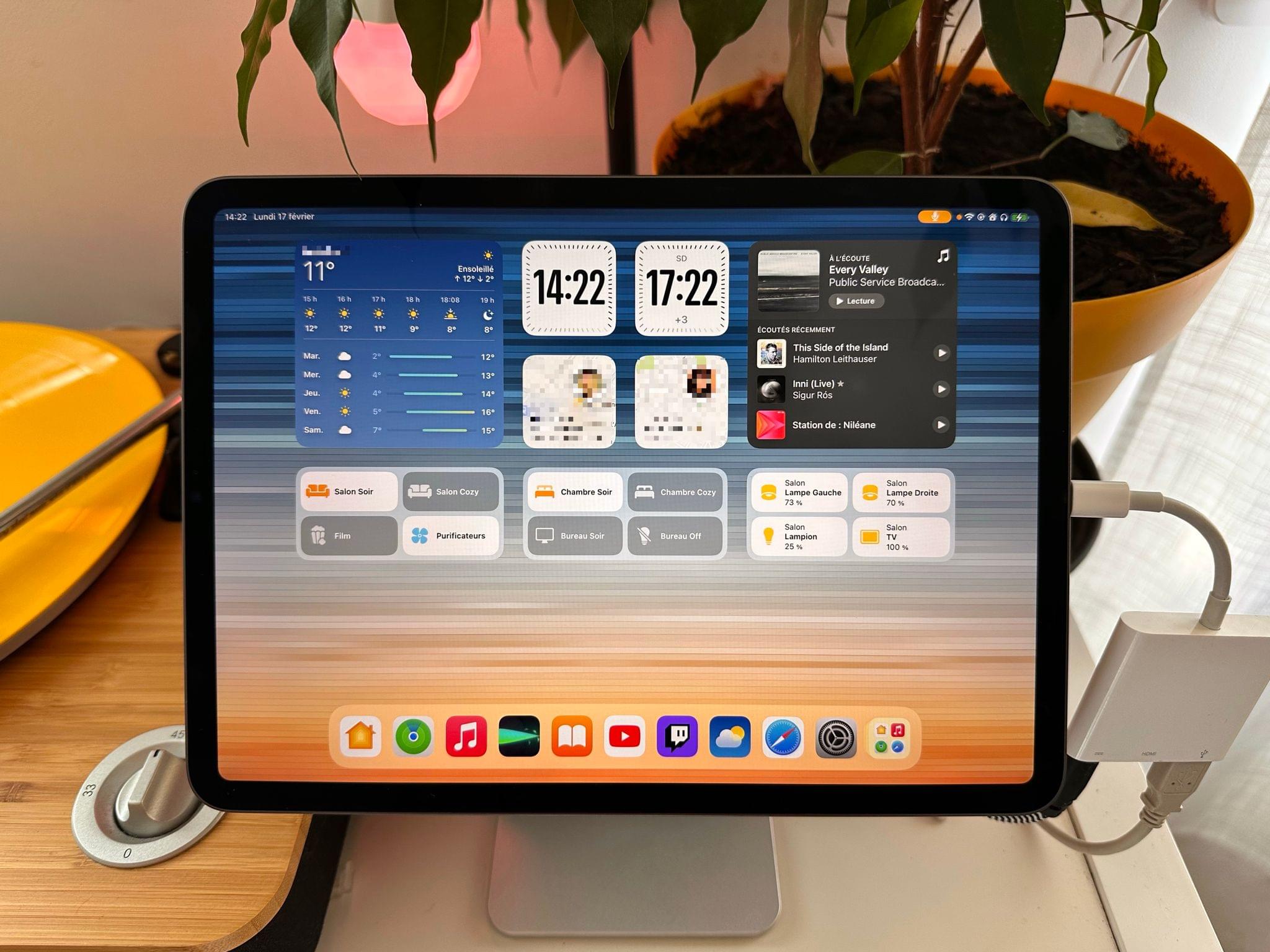This month, amidst the increasingly chaotic rumblings of the world in the news, I found myself looking for a new distraction. Since Civilization VII wasn’t out just yet, my eyes quickly turned to the vinyl record player that my partner and I had been storing in its cardboard box for months without ever taking the time to set it up. It’s not even ours; we’ve been keeping it safe, along with a sizable vinyl collection, for a close friend who unfortunately doesn’t have enough space for it in their current home.
This turntable is definitely not fancy – it’s even quite affordable compared to similar models – but it looks pretty, and our friend gracefully gave us permission to set it up for ourselves in the living room. While I’m sure they only pitied my desperate need for a new distraction, I took them up on this offer and opened the turntable’s box for the first time.
At the risk of sounding like a total youngster, I must disclose that until three weeks ago, I had never interacted with vinyl before. All I had were some presumptuous preconceptions. ”Doesn’t music sound worse on vinyl? Also, why should I bother with large, fragile music discs and a whole record player when I already have Apple Music in my pocket with lossless audio and Dolby Atmos?”
Still, I was not only intrigued, but also motivated to solve the main problem that setting up this record player posed: how can I make it work when our audio gear at home consists only of a handful of HomePod minis, one pair of wired headphones, and several pairs of Bluetooth headphones? While some turntables ship with built-in Bluetooth connectivity, ours can only output audio over USB or RCA with the help of a sound amplifier, and it definitely can’t broadcast audio to AirPlay devices like our HomePod minis.
Allow me to spoil the ending of this story for you: in the end, unboxing this turntable escalated into a legitimately awesome tech upgrade to our living room. It’s now equipped with a docked 11“ iPad Pro that acts as a shared dashboard for controlling our HomeKit devices, performing everyday tasks like consulting the weather and setting up timers, and of course, broadcasting our vinyls to any HomePod mini or Bluetooth device in the apartment. This setup is amazing, and it works perfectly; however, getting there was a tedious process that drastically reinforced my long-standing frustrations with Apple’s self-imposed software limitations.
Let me tell you how it all went.
First, let’s head to the music store, because – let’s face it – while our dear friend allowed us to pick through their vinyl collection, I must admit that their taste is more akin to what my father would enjoy than to my own music preferences. The Beatles, Simon & Garfunkel, and AC/DC are all-time greats, but I needed to get started knowing I’d be able to enjoy some of my absolute favorite albums from this century. (Elyas, if you’re reading this, I love you, and your twentieth-century taste in music is valid.) I could write several surreal lines about what it felt like to browse through the vinyl section in the store, but here’s the short version: oh, am I thankful for the age of digital music where it doesn’t take 30 minutes and talking to an overworked human to find the album you’re looking for.
In the end, I went home with three beautiful albums in hand: Lungs by Florence + The Machine, I/O by Peter Gabriel, and Átta by Sigur Rós. Already, one of my presumptuous preconceptions about vinyl had collapsed. Yes, these records are fragile and difficult to store, but they are beautiful collectible objects, and now I can absolutely understand why people feel excited about growing their own collections. For me, the cherry on top was discovering the lovely saturated yellow color that Sigur Rós picked to stylize their latest album on vinyl.
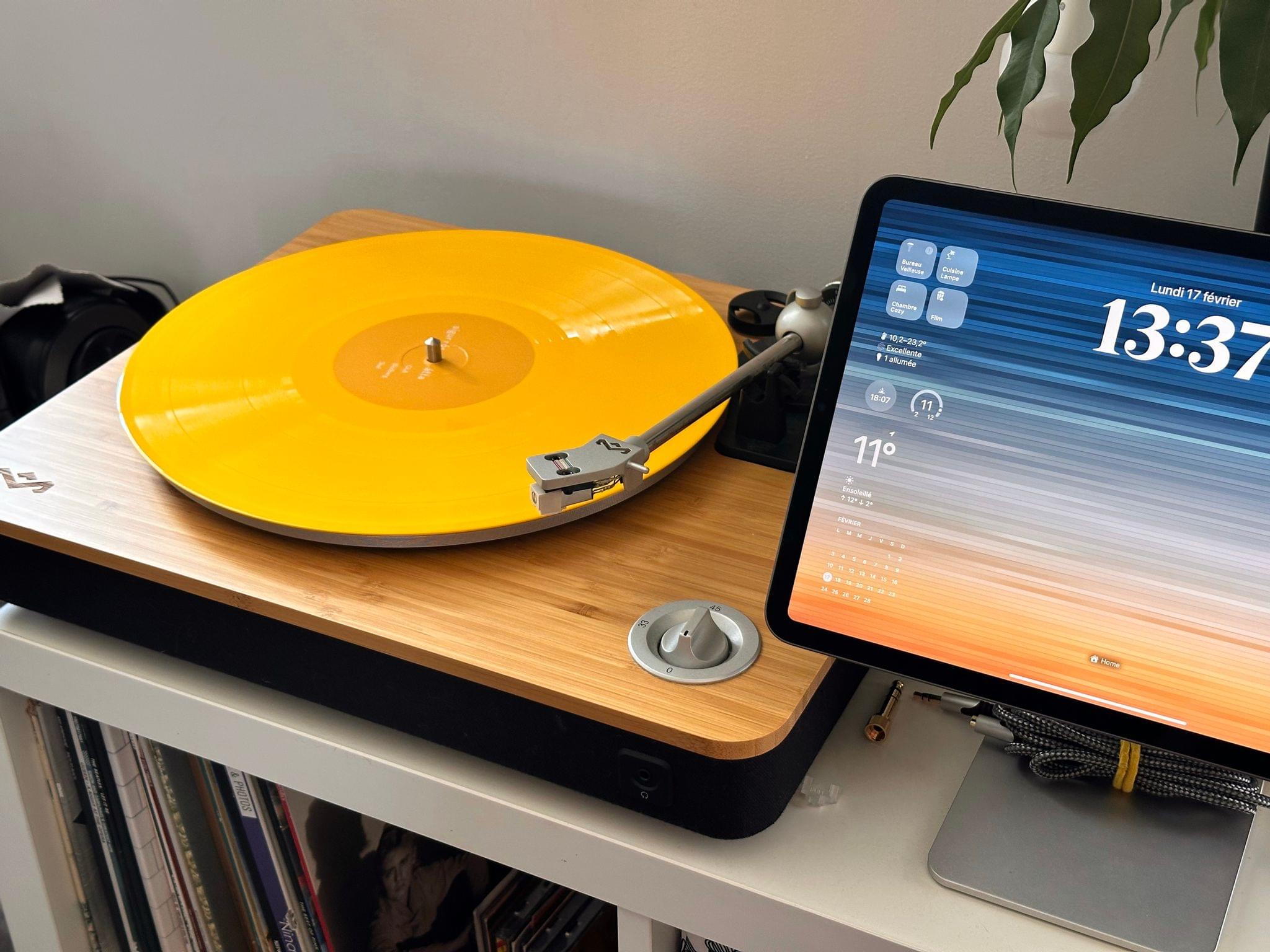
My all-time favorite band chose my favorite color to stylize their latest album on vinyl. Coincidence? I think not.
With the end goal of being able to listen to those three albums in mind, I started to research a way to connect my wired, open-back, over-ear headphones to the turntable, which features two classic RCA ports and a 3.5 mm headphone jack. The latter works out of the box with my 32-ohm Samson SR850 headphones, but in order to adjust the volume, I had to purchase a headphone amplifier. Considering my tiny budget for this project, I ended up going with a straightforward, well-reviewed model I found on Amazon France. All I had to do was connect the amplifier to the turntable using a couple of white and red RCA cables and plug the headphones into the amplifier’s headphone jack.
This alone was a delight. I found myself lying on the couch with my headphones on while watching the yellow vinyl record gently spin on the turntable. You guessed it: this is when another of my presumptuous preconceptions fell. Music on vinyl sounds beautiful – different and somewhat worse than when it comes from my phone, but beautiful nonetheless. I fully realize that my appreciation for vinyl probably comes from the satisfaction I feel when carefully dusting off a record, setting down the needle, and watching the contraption come alive both audibly and visually, but I think all of this combined made my first listening experience special.
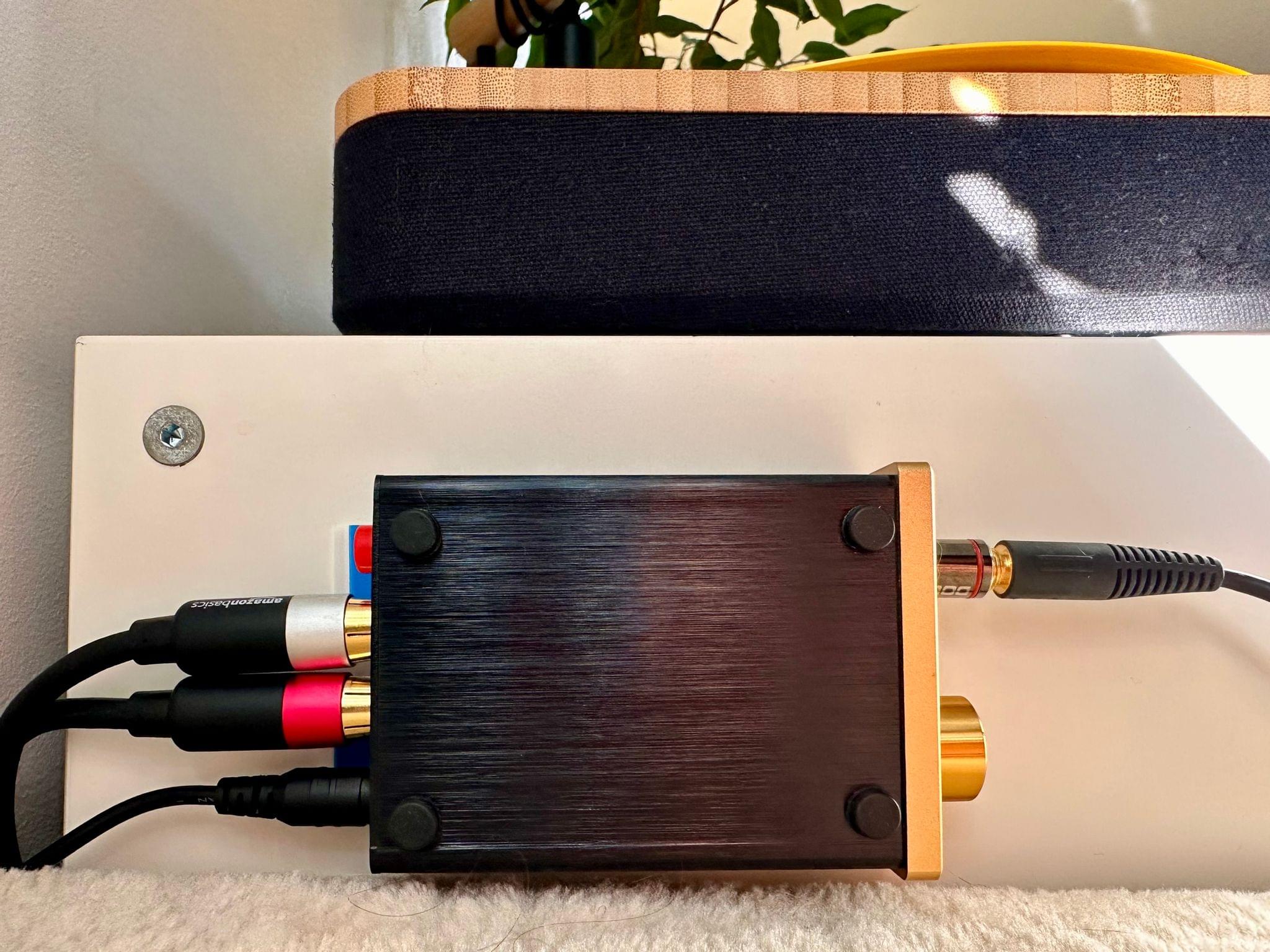
Using a small piece of double-sided tape, I mounted the headphone amplifier to the side of the furniture, right next to the record player.
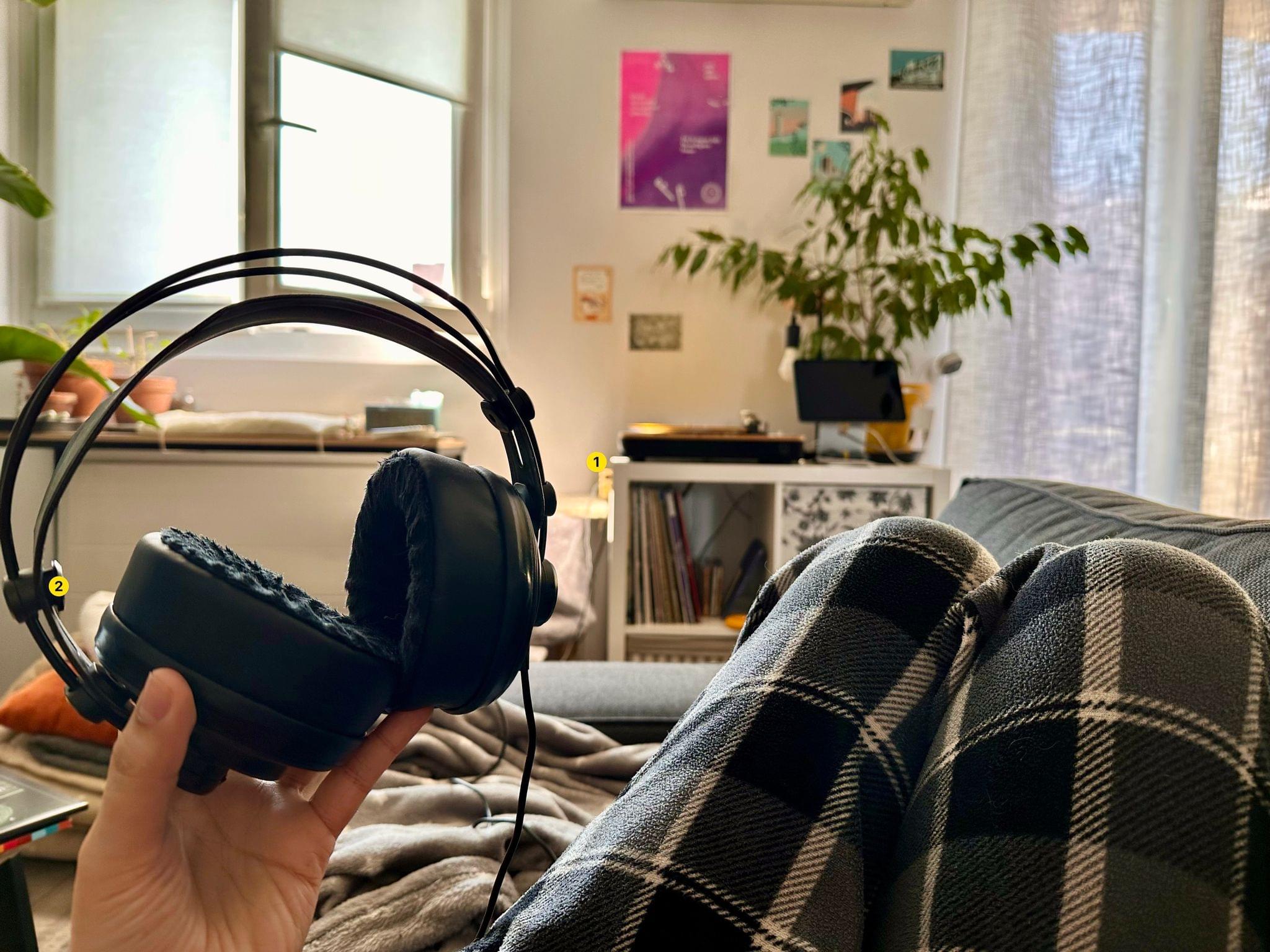
About to enjoy a vinyl record for the first time from the couch (reenactment). The headphones’ (2) cable is long enough to reach all the way down to the headphone amplifier (1).
Fortunately, this story doesn’t end with my naïve retelling of my first experience listening to a vinyl record. I still had a problem to solve: my open-back headphones are great, but it felt silly that my partner and I couldn’t listen to this music together on the HomePod minis in our living room. As you may know, HomePods are wireless speakers. They can’t be plugged into an audio source directly, and unlike many other wireless speakers, they also can’t connect over a standard Bluetooth connection. The only way to broadcast to a HomePod is to leverage Apple’s AirPlay protocol, which is natively supported across the company’s devices running macOS, iOS, iPadOS, and tvOS, but not an option for our record player. Despite this major gap in connectivity between our very basic turntable and the speakers we already owned, I was determined to make this work without resorting to purchasing any additional audio gear.
After some reading and web searching, I realized that the turntable’s USB-B port wasn’t there just because a factory worker mistakenly thought they were assembling an old-school printer. In fact, the port can be used to output audio directly to a computer. So using a USB-B to USB-A cable, along with a USB-A to USB-C adapter, I connected the player to my M2 MacBook Air. Oddly, the turntable’s audio was detected as an input by macOS and therefore could only be used as a microphone source. This meant that I couldn’t just route the audio to the MacBook’s speakers or any other audio output.
There is no simple way built into macOS to redirect an input audio feed to an output device. However, third-party audio utilities can do just that. Namely, Rogue Amoeba’s Airfoil, a great utility that lets you stream audio from a Mac to any AirPlay-compatible device on your network, includes the ability to select an audio input device as a source and stream that audio to your HomePods, which is exactly what I needed. I’m happy to report that after launching Airfoil, selecting the USB audio input as the source, and setting our living room HomePod minis as the destination, this setup immediately worked. My partner and I were finally able to listen to our vinyl records together over AirPlay using our existing speakers.
This setup was quirky, but it was also great in the sense that it reliably worked. At the same time, it added several additional steps to an already tedious process. We had to bring a Mac to the living room, plug it into the turntable, and use Airfoil to set the source and destination every time we wanted to sit down to enjoy our vinyls.
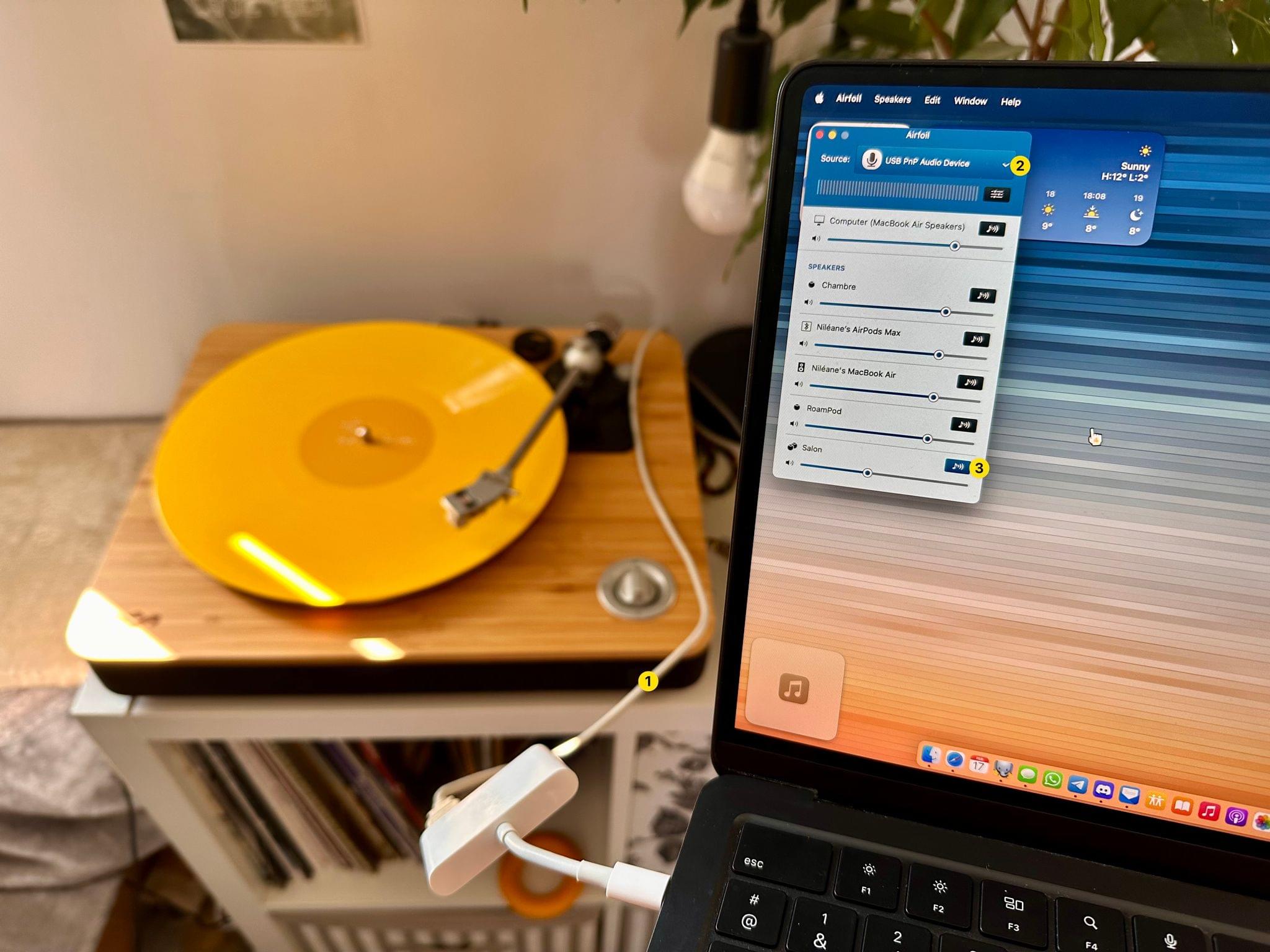
With my MacBook Air connected to the record player via USB (1), I am able to launch Airfoil and use the app to stream the input audio source (2) to our living room HomePod minis (3).
Thankfully, it was at this point that Jonathan knocked on my door (by that, I mean he messaged me on Discord) and reminded me of the very first column he wrote for MacStories Weekly, our newsletter that goes out to Club MacStories members every Friday, back in June of 2023. In the story, he showcased a delightful vinyl companion app for iOS and iPadOS called Quanta that’s developed by WWDC Swift Student Challenge winner Christian Privitelli. Jonathan wrote:
Quanta uses an existing iPhone or iPad to AirPlay music from your turntable to any AirPlay-compatible playback device. The setup is delightfully simple. I’ve been using the app on my iPad mini, but you can also use an iPhone if you wish.
After taking a minute to pinch myself out of frustration for forgetting about this column and bothering with my Mac, I immediately headed to the App Store and installed Quanta to try it out on my 11” iPad Pro. It is indeed a delightful app that acts not only as an audio interface to stream your vinyls to AirPlay-compatible speakers, but also as a beautiful display to showcase the music that is currently playing.
To make it work, all I had to do was connect the turntable’s USB-B port to the iPad’s USB-C port via the same cable and adapter I used with my Mac and launch the app. As soon as I did, Quanta immediately recognized the Sigur Rós track that was playing on the turntable using the Song Recognition API, and the album’s cover art appeared on my iPad’s screen. I was then able to tap the AirPlay icon in the app to send the music to our HomePod minis. A few minutes later, the next track started to play, and Quanta updated the information on-screen to match, which was also super satisfying to watch. Thank you, Jonathan, for this perfect two-year-old recommendation.
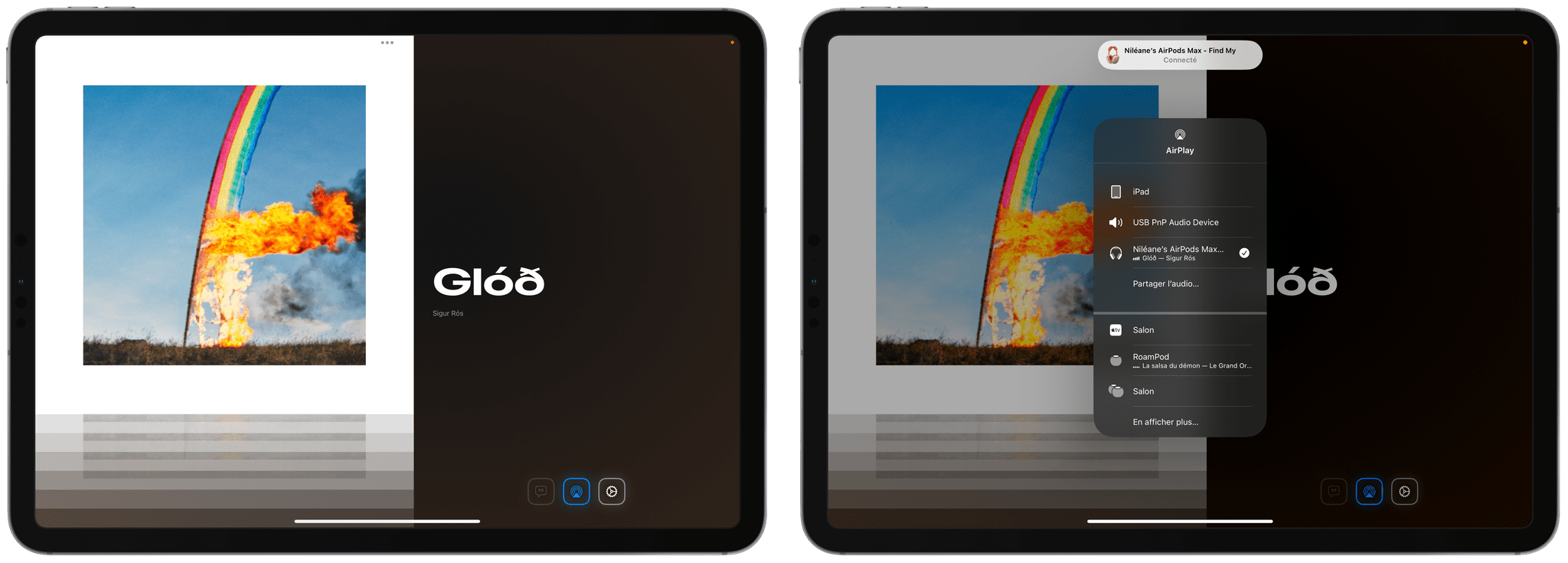
Quanta displays the album’s cover art as soon as the song is detected. To listen via AirPlay, tap the blue AirPlay button in the bottom-right corner.
Watching Quanta detect songs as soon as they start playing is very satisfying.Replay
Combined with Elago’s magnetic iPad stand, this setup looks amazing in the living room – so much so that I’ve decided to permanently leave the iPad Pro docked in this way for both my partner and me to enjoy. Now, the iPad acts as an always-on dashboard to control our HomeKit lights and appliances, as well as a delightful display for our vinyl record player.
However, even with a simple AirPlay solution in place, one issue yet remained. In 2025, the iPad is inexplicably still a single-user device. Unlike the Apple TV, it is nearly impossible to set up multiple Apple Accounts on one iPad. The device was signed in to my Apple Account, so if I wanted my partner to be able to unlock the device at any time without my help, I would have to leave Face ID turned off. That meant I would also have to trust that no one else visiting our home would poke around the OS to look through my private photo library and Safari history or send messages to any of my contacts via iMessage. This was a privacy risk that I was not willing to take.
In the end, because of the lack of multi-user support on iPadOS, I created an entirely new Apple Account dedicated to this shared iPad at home. It was clean of any personal information, and as such, it could safely remain permanently unlocked without Face ID or a passcode. As a bonus, I added the Apple Account to our Family Sharing group so it could access any of my purchases from the App Store, as well as our Apple Music subscription.
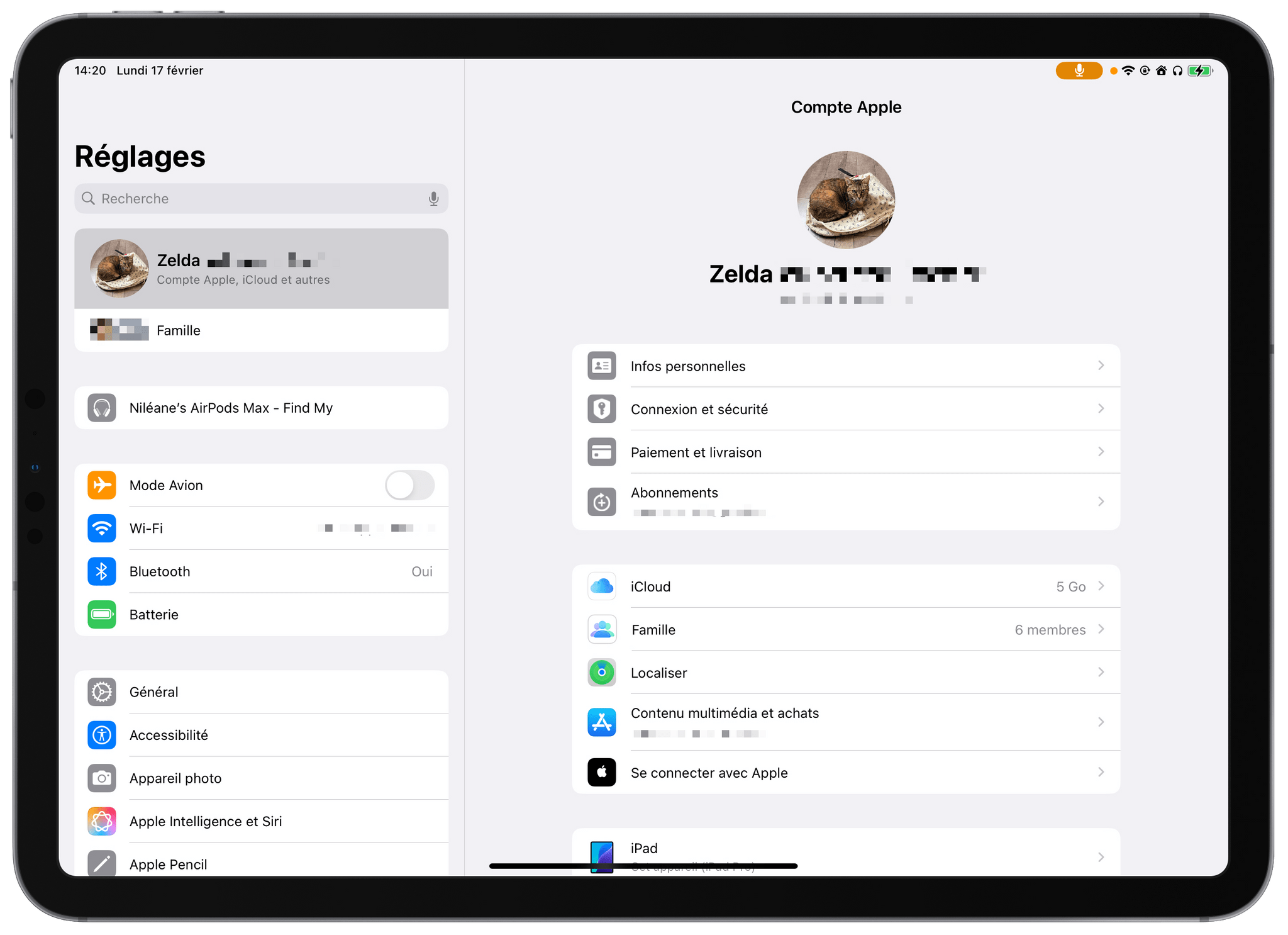
I created a brand-new Apple Account dedicated to our shared iPad. I named it after our only child (our cat, Zelda).
As I’m writing this, I can safely affirm that my desperate need for a new distraction perfectly collided with my affection for music in this project. Years ago, when I got my first decent salary, I immediately set my sights on purchasing a nice pair of headphones; today, I’m blessed with the comfort of AirPods Max, lossless audio via Apple Music, and a cozy corner in our living room where I can rest and enjoy some of my favorite music thanks to our turntable. From the first moment, vinyl has tingled all the right senses in my body, from the satisfaction of unwrapping a yellow Sigur Rós album to that of making it work with my current gear without spending large sums of money that I don’t have.
Nevertheless, even though the iPad and Quanta enabled me to have a reliable and easy way to listen to vinyl on my HomePod minis in the end, I cannot help but think that, throughout the entire process, AirPlay and Apple’s operating systems have felt more like a trap that I’ve fallen into than an enjoyable ecosystem. Had the HomePod minis supported a wired connection, or even just standard Bluetooth connectivity, simpler solutions would have prevailed to create this setup. Had iPadOS added the ability to log in with multiple Apple Accounts so I could safely share my device with my partner, my cat wouldn’t have an Apple Account to her name right now.
The analog nature of vinyl has relit the red alarm in my brain that periodically reminds me of the far too elegantly toxic relationship that Apple entertains with my digital life. Sadly, this red alarm just keeps lighting up these days.


